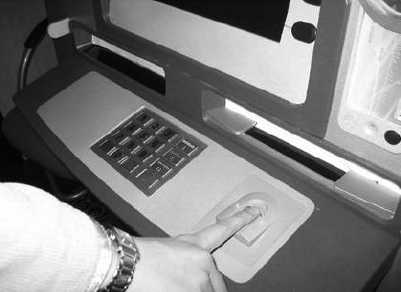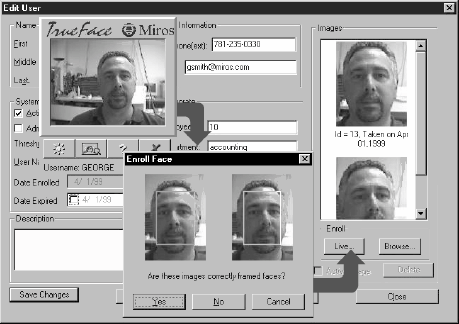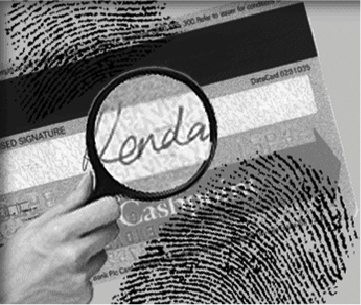Section 10.3. Biometrics and Public Technology: The ATM Example
10.3. Biometrics and Public Technology: The ATM ExampleAs different application areas place different requirements on biometrics technology, we must consider the appropriateness of different technologies for a specific application. This section explores the applicability of the different biometrics technologies for use within an ATM or other self-service environment. For a number of reasons (to be enumerated in the following sections), I assume here that verification rather than identification will be utilized at an ATM. 10.3.1. ATM Fingerprint VerificationIntegration of fingerprint sensors into an ATM for verification is feasible, especially if contact silicon (capacitance or thermal swipe) devices are used (see Figure 10-1). Optical sensors and static capacitance systems are not viable for ATMs because of dirt and latent prints that accumulate with use. Swipe devices, on the other hand, at least have the potential for self-cleaning with use. Unfortunately, the physical positioning of the sensor may be difficult for all users (left-handed/right-handed aside) to get their fingers flat on the reader. Smart cards equipped with fingerprint sensorswhere the fingerprint is used to allow use of a private keycould remove many of the technical problems of deploying biometrics in the self-service environment. Figure 10-1. Fingerprint reader 10.3.2. ATM Face VerificationAnother possibility for ATMs is the integration of facial biometrics systems (see Figure 10-2). In many cases, a security camera is already present; this camera could be used for both video recording and biometrics verification. Because face verification could be a universal biometricseverybody has a facemost research on this technology to date has focused on the potential negatives. Several complicating factors have been identified:
On the positive side, face recognition presents no hygiene-related health concerns and no current association with criminology. This biometrics technique can also be used without the user's cooperation or even his knowledge, as a backup or addition to any other biometrics deployed, potentially raising privacy concerns. Figure 10-2. Face recognition 10.3.3. ATM Iris VerificationIris verification is the most reliable biometrics, but currently it is still very expensive for systems that do not require the user to put her eye in close proximity to the camera (see Figure 10-3). (Such positioning could cause problems in an ATM environment for the same reason that it is problematic for face recognition.) Iris verification has already been piloted in ATMs. On the positive side:
On the negative side:
If performance accuracy were the only criterion for adoption, this system would be more popular. However, the difficulty of positioning the eye remains a problem. Advances in both algorithms and robotics to direct the camera to the eye instead of requiring the user to position the camera or eye manually will surely make this technology more successful. Figure 10-3. Iris scanner 10.3.4. ATM Retina VerificationMany reasons exist for not using retina verification and existing retina systems in ATMs. These include:
Retina verification systems may evolve, and theoretically their performance is attractive, but at present they have too many negative aspects to deploy in any capacity. 10.3.5. ATM Hand VerificationThe finger geometry system has some potential, but at present the integration of a hand sensor into an ATM would be difficult for a number of reasons:
10.3.6. ATM Speaker VerificationSpeaker verification uses the user's voice as an authenticator. There are many advantages to this technique at an ATM:
However, there are some negatives:
10.3.7. ATM Signature VerificationWith a signature verification system, the computer verifies a physical signature that the user writes with either pen-and-ink or a special pen on an electronic pad (see Figure 10-4). This system is very attractive for use with financial transactions because of the long historical and present-day association between signature and financial authorization. What's more, an image of the signature can be preserved for later human scrutiny. Signature verification systems can be integrated directly into an ATM, although the location of small tablets and pens can pose a usability problem for some users. Although this technology is intriguing, it has not yet proven to be reliable. 10.3.8. ATM Typing VerificationIt is unlikely that everyone would have sufficient typing skills or practice to be comfortable with the typing verification technique, even if a standard alphanumeric keyboard were available on all ATMs. Such a keyboard would require space and careful placement so that its use could mimic that of a desktop-based keyboard. If full keyboards were to become the norm on many self-service devices, one could see the attraction of this relatively unknown biometrics technique, but otherwise, the technique is infeasible. Figure 10-4. Signature verification |
EAN: 2147483647
Pages: 295